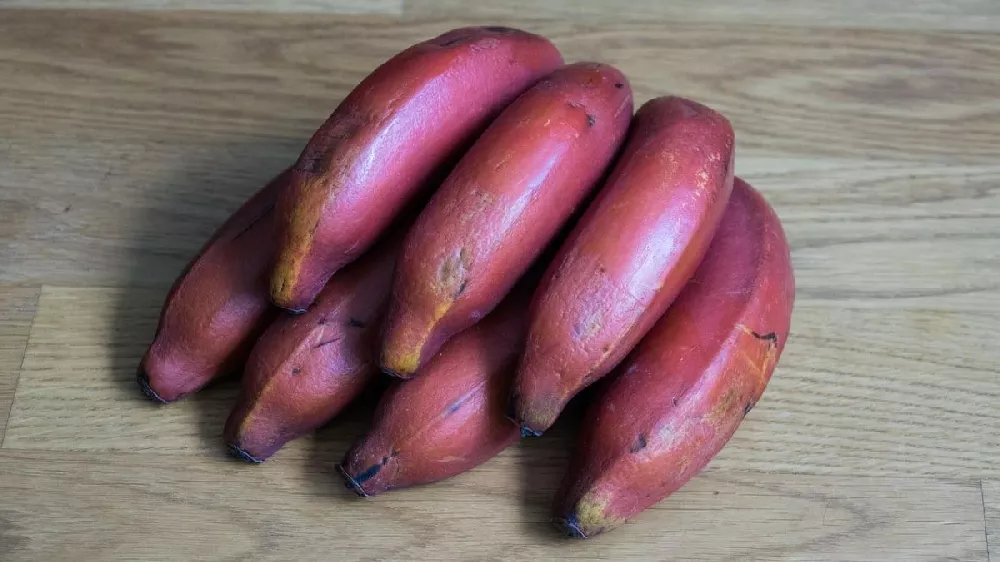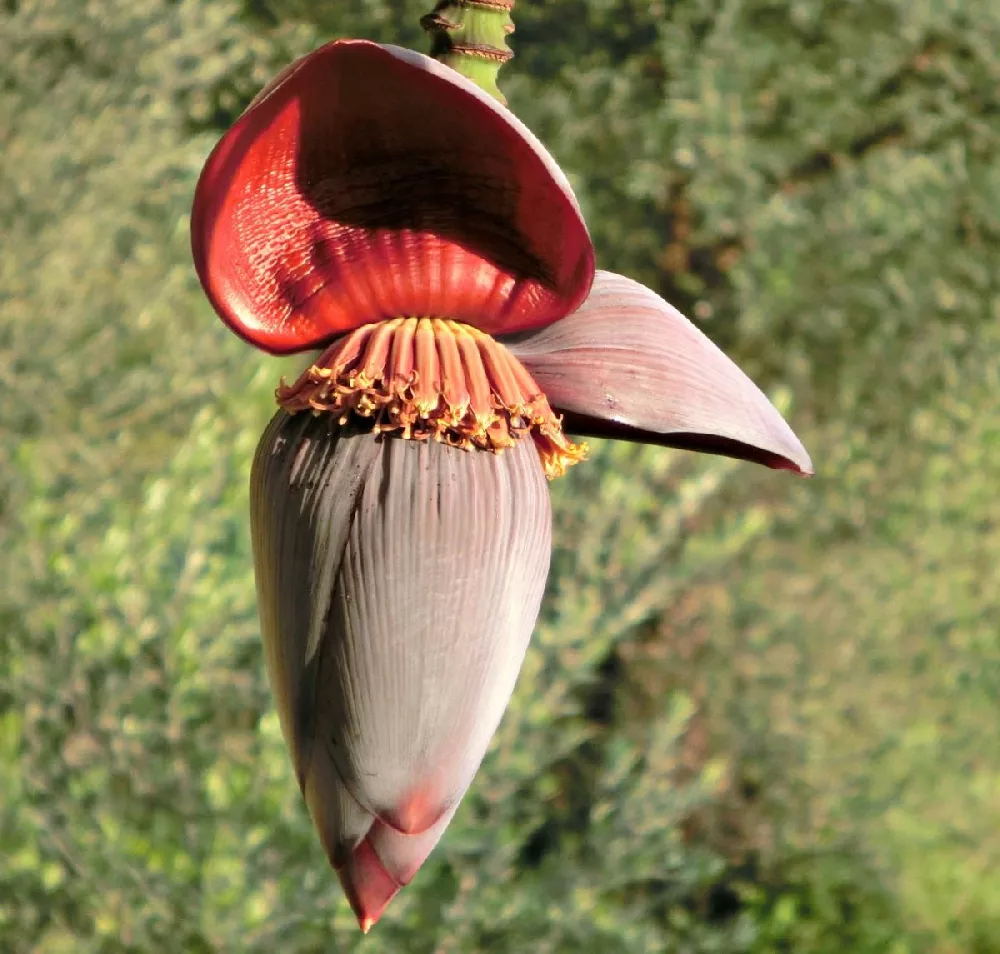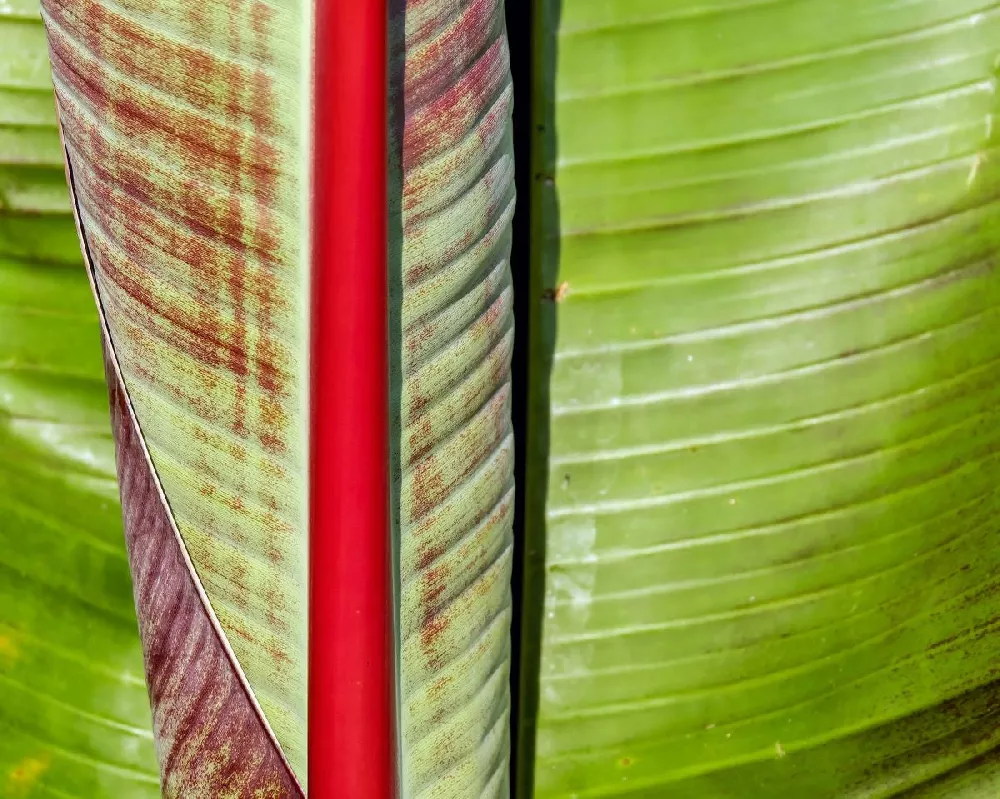- Home >
- Edible Plants >
- Dwarf Red Banana Tree
Dwarf Red Banana Tree for Sale - Buying & Growing Guide
While red bananas are less common than the yellow ones you are likely used to, they can be just as delicious and easy to grow. If you wish to try one for yourself, all you need to do is raise a dwarf red banana tree, Musa sp., of your own. Along with being an excellent producer of fruit, the dwarf red banana tree also holds immense ornamental value. The main source of that beauty is this plant's leaves, which are incredibly large and have a unique coloration that consists of varying shades of dark green and red.
- The dwarf red banana’s large, broad leaves are dark green and red.
- It produces large bunches of red bananas.
- It grows quickly and can survive in containers.
Enter your zip code to find nearby stores that may carry this plant.
Plant Care
Sunlight

This plant needs as much sunlight per day as possible for fruit production.
Watering
The dwarf red banana tree requires water on a very frequent basis, about once every one to three days during the growing season.
Fertilizing

Fertilize monthly with a fertilizer that is balanced or has a slightly higher ratio of phosphorus.
Planting and Care
Planting instructions
Full sunlight is a necessary prerequisite for anyone hoping to grow a dwarf red banana tree. In fact, the more sunlight that reaches your growing area, the better this plant will grow. You will have the option to grow your dwarf red banana tree in the ground or in a garden container. Regardless of which you choose, the soil in which this plant grows should have good drainage and plenty of organic nutrients. Also, dwarf banana trees typically show the best growth in slightly acidic soils and warmer regions such as hardiness zone 8 and warmer.
Watering and nutrients
If you wish to produce the healthiest growth and the greatest quantity of fruits, you will need to water and fertilize your dwarf red banana tree frequently. During the growing season, a dwarf red banana tree needs water at least every three days. However, you may need to water your tree as frequently as once per day, depending on the weather. You should also fertilize your dwarf red banana tree often. The best approach is to feed this plant once every month with a balanced fertilizer or one that is slightly higher in phosphorus.
Pollination
One of the most unique traits of the dwarf banana tree, and other banana varieties, is that it does not require pollination to produce fruits. Instead, the female flowers of these plants simply develop into bananas on their own. Interestingly, it is possible for an insect to pollinate a banana tree. However, this is an unwanted outcome for most, as pollinated banana trees produce fruits that are full of seeds and far less enjoyable to eat.
Pruning
Another interesting fact about banana trees, including dwarf banana trees, is that each stalk that emerges from the ground will provide only one harvest. After harvesting the fruits of this plant, you should prune the stalk back to the ground. Removing the stalk is one of the most important maintenance tasks when caring for a dwarf red banana tree, as doing so allows the plant to produce a new stalk that will eventually bear fruits.
Pests, diseases, and animals
When caring for a dwarf red banana tree, you should inspect it often, as this tree can encounter problems with pests and diseases. Nematodes are among the insects that are most likely to cause harm to this tree. Not only do nematodes eat the roots of dwarf red banana trees, limiting the plant’s ability to absorb nutrients, but they are also capable of spreading fungal infections. As such, you should be well aware of what nematodes look like and how to get rid of them before planting a dwarf red banana tree.
Harvesting
Generally, it takes about 18 months for a dwarf red banana tree to develop a stalk and produce harvestable fruits. As those fruits mature on the tree, watch as their color changes. Once the color has become dark reddish brown, your bananas are ready for harvest. You can harvest these fruits by removing the entire solitary bunch of bananas that this plant produces. After you pick your bananas, be sure to cut the stalk back to allow for future harvests.
Achieving maximum results
Many gardeners wish to grow the dwarf red banana tree for the incredible fruits these plants produce. However, the high sunlight needs of this species can make it difficult to achieve the goal of fruit production. But if your growing location does not receive enough light for fruit to grow, the plant itself will continue to survive. This means that the opportunity to grow the dwarf red banana tree for its ornamental appeal remains possible if your garden sits in partial shade.
FAQs
Can you grow a dwarf red banana tree indoors?
It is possible to grow a dwarf red banana tree indoors, as this species can adapt to a container growing setting. However, it is very difficult to find an indoor growing location that receives enough sunlight for this plant to produce fruits. But while your dwarf red banana tree is unlikely to produce fruits when growing indoors, it remains a valuable plant option due to its beautiful foliage.
What does a red banana taste like?
Most people are used to eating the yellow bananas, known as Cavendish bananas, that populate most grocery stores. However, those who have tried red bananas sometimes find these fruits to have a better taste and texture than most other banana varieties. Red bananas are quite sweet with a hint of tartness and a rather soft texture. Those qualities make red bananas great to eat raw or to incorporate into baked dishes.
What is the best spacing for multiple dwarf red banana trees?
While the dwarf red banana tree will produce a large number of bananas, this ample harvest may not be enough for some gardeners. Those gardeners may choose to grow an entire stand of dwarf red banana trees rather than a single plant. If you choose to do that, you should space your dwarf red banana trees about 4 feet from one another.
You can't add more Product Name - Product size to the cart.
OK



